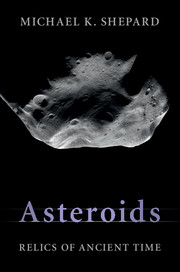Book contents
- Frontmatter
- Dedication
- Contents
- Preface
- Acknowledgements
- Brief list of asteroid and meteorite terms
- 1 It's a small world
- 2 A night at the zoo
- 3 It came from outer space
- 4 A day at the museum
- 5 The gambler's fallacy
- 6 Remembrance of things past
- 7 The ties that bind
- 8 Terra incognita
- 9 To your scattered bodies go
- 10 Scouts, sappers, and miners
- Glossary
- Bibliography
- Index
- References
5 - The gambler's fallacy
Published online by Cambridge University Press: 05 May 2015
- Frontmatter
- Dedication
- Contents
- Preface
- Acknowledgements
- Brief list of asteroid and meteorite terms
- 1 It's a small world
- 2 A night at the zoo
- 3 It came from outer space
- 4 A day at the museum
- 5 The gambler's fallacy
- 6 Remembrance of things past
- 7 The ties that bind
- 8 Terra incognita
- 9 To your scattered bodies go
- 10 Scouts, sappers, and miners
- Glossary
- Bibliography
- Index
- References
Summary
The dice of God are always loaded.
Ralph Waldo Emerson, Compensation
THE AWAKENING
For two centuries, asteroids were discovered randomly by astronomers attempting to do other “real” work in astronomy. With the exception of the first decades after the discovery of Ceres, there does not appear to have been any systematic effort to discover more. Eros, the 433rd numbered asteroid, was not discovered until nearly a century after Ceres. And by the 1980s, well into the modern astronomical era, only a couple of thousand asteroids had been discovered; of those, only a handful were in reservoirs other than the main belt. Since then, though, discoveries have accelerated; at present there are more than 400,000 numbered asteroids. Why the sudden quickening? It is because we are searching scared, using dedicated telescopes, high-tech instruments, and increasingly sophisticated software to extract these tiny needles from the cosmic haystack.
Culturally, there has been a shift. Until recently, there was no urgency for this search task. But several events have frightened us and made the effort worthwhile to those who control purse strings. Perhaps the watershed event was the discovery and subsequent impact of Comet Shoemaker–Levy 9 into Jupiter in 1994. A few scientists, including Gene Shoemaker (1928–1997), had been warning us of the threat of an impact for years. Shoemaker's role in proving that Meteor Crater, Arizona, was from a relatively recent impact had convinced him and others. But still, events of 50,000 years ago – the estimated age of that impact – don't register with most of us. Our temporal horizons are much closer.
Shoemaker, his wife Carolyn, and friend David Levy had worked together for years surveying the sky for asteroids that could approach and potentially hit the Earth. In March 1993, the trio discovered their ninth periodic comet together, and following the naming convention, it was designated Shoemaker–Levy 9 (SL9).
- Type
- Chapter
- Information
- AsteroidsRelics of Ancient Time, pp. 131 - 158Publisher: Cambridge University PressPrint publication year: 2015



